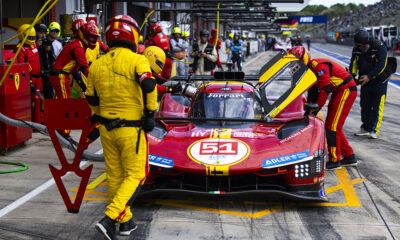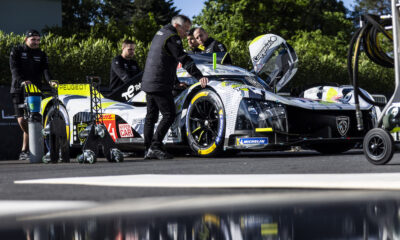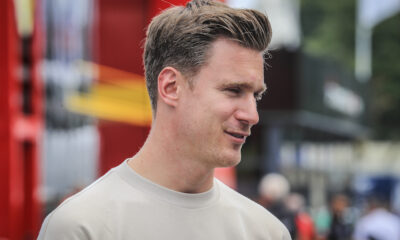FIA World Endurance Championship drivers have weighed in on the off-season changes made to Circuit de Spa-Francorchamps including modifications around Eau Rouge, more trackside gravel and a partial resurfacing.
Extensive winter upgrades were made to the Belgian facility as part of a €25 million ($26.4 million USD) investment to improve safety and diversify track operations, including the attainment of FIM Grade C status for the venue to host high-level motorcycle racing.
Notable changes include enlargement of the tarmac run-off at Raidillon and repositioning of the barriers upon entry to Eau Rouge, as well as an imposing 4,600-seat grandstand overlooking the iconic uphill section.
Track resurfacing work has taken place through the Eau Rouge/Raidillon complex and at the beginning of the second sector from Bruxelles to Pouhon.
Several tarmac run-off areas have been filled with gravel that now sits at the track limits border in certain places, most notably at Turn 9 and Stavelot.
The 4.3-mile layout is unchanged since last year, but adjustments to features around the circuit have altered the experience of a lap behind the wheel of a prototype or GTE car.
“They’ve resurfaced Eau Rouge, so the bumps are no longer there in that compression,” United Autosports LMP2 driver Phil Hanson told Sportscar365.
“It’s difficult to really know how much more grip there is because we’re slower with the lack of downforce and power. We’re like 8 km/h slower than we were there last year.
“So it’s not really a corner anymore, it’s flat on the out-lap.
“The rest of the track is very similar until you get to Turn 8 [Bruxelles] and 9 where they’ve resurfaced the track and there is so much more grip.
“Turn 8 was always a really challenging corner with the rear axle on traction. If you didn’t have your right-front wheel right on the apex, you would wash out with understeer.
“Now you can’t get off the brakes quick enough because there’s so much minimum corner speed to be taken.
“At Turn 9, where they haven’t quite finished the curb and the resurfacing, it’s really fast and more of a rounded corner, less sharp. So the minimum speed is much quicker there.”
It remains to be seen how the resurfaced sections will affect driving in wet conditions, with the WEC practice sessions held so far all taking place in dry weather.
Hanson estimated that LMP2 lap times would be around three to four-tenths of a second faster than last year if the class had not received further performance cuts this season.
The United driver also believes that some parts of the track have become more “claustrophobic” after gravel was added to more of the run-off areas.
Notable gravel traps can now be found at the exits of La Source and Fagnes, and on the right-hand side through Les Combes.
Toyota Gazoo Racing driver Brendon Hartley feels that the implementation of new gravel areas will raise the stakes considerably.
“It’s not changed so much [in layout] but there’s a lot of gravel everywhere now, a lot higher risk for having a mistake and going into the gravel,” Hartley told Sportscar365.
“In some ways I like these high-risk places, it makes you think a bit more before you try and brake 20 meters later than the lap before.
“It’s actually what I think us professional drivers somehow like. It’s hard to know if it’s going to create more red flags, safety cars or Full Course Yellows. Hopefully not.
“Maybe it also brings people back a step because they know the higher risk is there, so it can go in one of two ways.”
Porsche GT Team’s Kevin Estre is also pleased with the implementation of gravel in some run-off areas but feels Eau Rouge should have been included in that process.
The Frenchman told Sportscar365 that he believes the corner has been made less challenging after the off-season modifications.
“Overall, for me it’s positive everywhere,” Estre said. “To add some gravel was a good call.
“Eau Rouge I would say has a bit more grip than before with the new asphalt and a bit less harsh compression.
“This is the only thing where I would have liked to keep it exactly the same and it’s not.
“And for me, it would have been nice to add some gravel at Eau Rouge on the left side because now you remove the wall, you push the barrier on the top more to the left, which brings the vision of a very open, very easy corner – a lot easier than it used to be.
“I would have liked to have some gravel to be honest, just mentally as a driver to know if you do a mistake you go to the gravel but don’t do track limits, which they did everywhere else apart from Eau Rouge and Blanchimont.”
Hanson suggested that the repositioning of barriers on the approach to Eau Rouge removes a “tunnel vision” effect previously felt on the run down to the famous corner.
“It does feel a bit weird going down to Eau Rouge without the wall on the left,” he said.
“It just feels a bit more open; you’re less in that tunnel vision looking into Eau Rouge. You’re more gazing down a bit.”
Estre, meanwhile, added that this opening of the Eau Rouge approach has removed some of the “respect” that the corner demands from a GTE driver.
“Eau Rouge is flat but on the edge and it’s a corner you need to have a lot of respect for,” he noted. “The respect went lower now, for us.
“Maybe not for this championship, maybe other championships with more young drivers might need even more respect for the corner, but it’s OK. Overall, I would say they’re good changes.”
In March, Circuit de Spa-Francorchamps CEO Amaury Bertholome stated that the off-season upgrades took part over a five-month period involving a team of around 250 people, as well as more than 100 machines and 30 businesses from the local region.
“We’re speaking about a lot of work in a very short timeframe,” he said.
“Renovation of all the run-offs, new gravel traps, resurfacing of some parts of the track and construction of a brand-new grandstand at the top of Raidillon.
“In the endurance area, in the descent from La Source towards the Raidillon, the stand and terraces will make their re-appearance in 2023.”
The WEC is the second sports car racing competition to visit the upgraded Spa facility, where the 24H Series held a 12-hour race two weeks ago.
Davey Euwema contributed to this report























